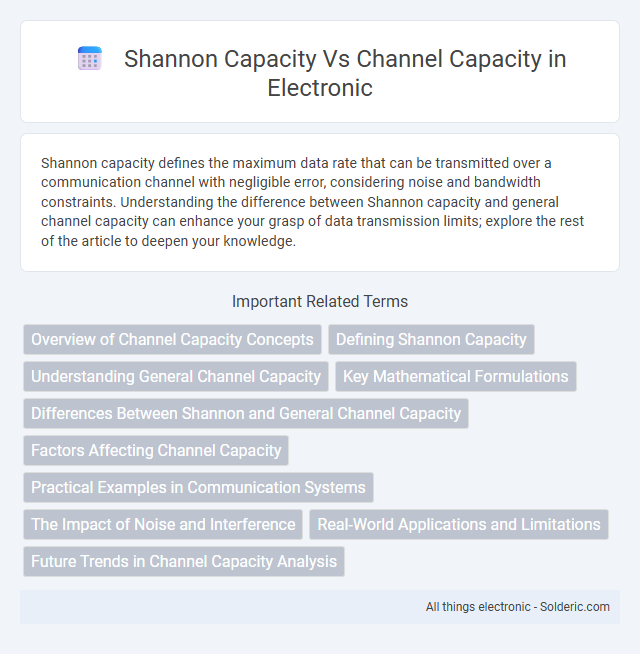Shannon capacity defines the maximum data rate that can be transmitted over a communication channel with negligible error, considering noise and bandwidth constraints. Understanding the difference between Shannon capacity and general channel capacity can enhance your grasp of data transmission limits; explore the rest of the article to deepen your knowledge.
Comparison Table
| Aspect | Shannon Capacity | Channel Capacity |
|---|---|---|
| Definition | The maximum data rate of a communication channel under ideal noise conditions, as defined by Claude Shannon. | The highest reliable transmission rate achievable for a specific communication channel considering actual physical and environmental constraints. |
| Focus | Information theory, theoretical limit based on signal-to-noise ratio (SNR). | Practical limit accounting for channel impairments, such as fading, interference, and bandwidth constraints. |
| Formula | C = B * log2(1 + SNR), where C is capacity, B is bandwidth, SNR is signal-to-noise ratio. | Varies with channel type; often estimated using empirical models or measurements. |
| Units | Bits per second (bps) | Bits per second (bps) |
| Scope | Applies primarily to additive white Gaussian noise (AWGN) channels. | Applicable to all channel types including AWGN, fading, and multipath channels. |
| Use Case | Benchmark for maximum theoretical data transmission rate. | Design and analysis of real-world communication systems. |
Overview of Channel Capacity Concepts
Channel capacity defines the maximum achievable data rate for reliable communication over a channel, constrained by bandwidth and noise characteristics. Shannon capacity provides a theoretical upper bound on channel capacity, calculated using the Shannon-Hartley theorem as C = B log2(1 + SNR), where B is bandwidth and SNR is signal-to-noise ratio. Understanding the distinction between practical channel capacity and Shannon capacity guides system design limits and performance optimization in digital communications.
Defining Shannon Capacity
Shannon Capacity defines the maximum data rate that a communication channel can reliably transmit without error, measured in bits per second. It is based on Shannon's Theorem and depends on the bandwidth and signal-to-noise ratio (SNR) of the channel. Understanding Shannon Capacity helps you optimize transmission rates while minimizing data loss and errors in digital communication systems.
Understanding General Channel Capacity
General channel capacity represents the maximum reliable data transmission rate that a communication channel can support under given noise and bandwidth conditions. Shannon capacity quantifies this upper limit using the Shannon-Hartley theorem, calculating capacity based on bandwidth and signal-to-noise ratio. Understanding your channel's capacity helps optimize transmission schemes to achieve efficient and error-free communication.
Key Mathematical Formulations
Shannon Capacity, defined by the formula C = B log2(1 + S/N), quantifies the maximum data rate over a channel with bandwidth B and signal-to-noise ratio S/N. Channel Capacity generalizes this concept, considering factors like channel state and coding, often represented as the supremum of mutual information I(X;Y) over input distributions. Understanding these mathematical formulations helps you optimize communication systems by approaching theoretical limits of data transmission efficiency.
Differences Between Shannon and General Channel Capacity
Shannon capacity specifically defines the maximum data rate achievable over a noisy communication channel with an arbitrarily low error probability, based on the Shannon-Hartley theorem. In contrast, general channel capacity refers to the ultimate rate at which information can be reliably transmitted over any communication channel, considering factors such as channel constraints, noise models, and coding strategies beyond Shannon's ideal assumptions. The key difference lies in Shannon capacity's reliance on theoretical Gaussian noise and ideal coding, whereas channel capacity encompasses broader real-world scenarios and channel characteristics.
Factors Affecting Channel Capacity
Channel Capacity depends on factors such as bandwidth, signal power, and noise level, directly influencing the maximum data rate achievable over a communication channel. Shannon Capacity defines the theoretical upper bound of this rate, considering the signal-to-noise ratio and bandwidth limitations. Your network's performance and reliability hinge on optimizing these parameters to approach the Shannon Capacity in practical scenarios.
Practical Examples in Communication Systems
Shannon Capacity defines the theoretical maximum data rate that a communication channel can support without error under ideal conditions, often used to benchmark system performance. Channel Capacity in practical communication systems accounts for real-world factors like noise, interference, and hardware limitations, leading to lower achievable rates than Shannon's limit. Examples include fiber-optic networks where channel capacity approaches Shannon Capacity under controlled noise, versus wireless systems such as LTE or 5G where fading and interference reduce effective data throughput.
The Impact of Noise and Interference
Shannon capacity defines the theoretical maximum data rate of a communication channel under the presence of noise, quantified through the signal-to-noise ratio (SNR). Channel capacity reflects the actual achievable data rate, often reduced by practical interference and signal degradation beyond ideal noise assumptions. Noise and interference reduce effective SNR, directly impacting channel capacity by limiting reliable data transmission rates in real-world communication systems.
Real-World Applications and Limitations
Shannon Capacity defines the theoretical maximum data rate of a communication channel without error under ideal conditions, serving as a benchmark for designing efficient coding schemes in real-world applications like wireless networks and data transmission. Channel Capacity, while related, represents the practical achievable rate influenced by factors such as noise, interference, hardware limitations, and environmental conditions, which often reduce actual performance below Shannon's theoretical limit. Understanding these distinctions helps you optimize communication systems by balancing theoretical potential with real-world constraints like signal attenuation and processing power.
Future Trends in Channel Capacity Analysis
Future trends in channel capacity analysis emphasize the integration of machine learning algorithms to predict and optimize Shannon capacity in dynamic wireless environments. Quantum communication advancements promise to redefine channel capacity limits by exploiting quantum entanglement and superposition, significantly enhancing data transmission rates. You can expect ongoing research to focus on multi-antenna systems and adaptive modulation schemes that push channel capacity closer to theoretical Shannon limits under real-world conditions.
Shannon Capacity vs Channel Capacity Infographic

 solderic.com
solderic.com